
Here and Beyond
10:00am - 6:00pm,October 28 - December 10, 2017 / Admission Free
[wp-blogro11 catname=air2017-5en orderby=ur1]
MOTOYAMA Yukari

photo: YAMAMOTO Tadasu
Heading toward lines to draw
ITO Satoko
Motoyama says that she was not able to focus on the act of painting, and blocking painting contexts and personal thoughts, she faces only the act of “drawing a superior line.”(*1)Included in this exhibition is her “Drawing paper series” in which she breaks down many elements such as motifs included in painting, compositions, and how to draw lines, reviewing her way of dealing with them one by one and leaving only what she thinks are necessary. Looking closely at the pictures arranged, you cannot grasp the materiality of paint directly because the surface is blocked by an acrylic board and you will realize that they are painted on the backside of the board. The matière that could convey time and emotions by layers of paint is made uniform by turning over the picture to urge the viewer to concentrate on appreciating the lines only. The lines seem free and easy at a glance and look humorous sometimes. I would like to explain the process of how the line and the face seen on the surface appear in Motoyama’s painting.
In the figures drawn in Motoyama’s pictures, the lines that are necessary for us to recognize what are drawn are cut down to the minimum. There is no information for explanation. Looking at the title to know if it shows a person or maybe a plate, the viewer finds a word that indicates nothing but what is drawn, and turns his/her attention to the presence of the lines that certainly look like that thing. The lines are drawn based on digital drawings. Daily scenes, still objects and landscapes chosen after excluding personal feelings and narratives are repeatedly drawn quickly over and over again to be stored as data. As the traces of matière such as overlaps of lines and textures do not remain in digital data, the judgment is made only by figures drawn by lines. Furthermore, there she takes time to examine carefully the quality of line, face and composition, and narrows down to several images. What is presented as a work is a picture drawn with paint on the acrylic board, and these drawings that are initially made are neither rough sketches nor studies, but “motifs” to see when she draws her works. Easily erasing lines or putting them back again means to move away from the act of drawing at the moment and to do a task like preparing a motif, that is the subject such as a still object when drawing a picture. For her to concentrate solely on drawing superior lines while looking at them on the acrylic board, it is an important process because it is necessary to decide all the elements such as composition and shape at this stage.
There is no ground in the painting space on a transparent support, and as the title of the picture indicates, a drawing paper itself should be painted to begin with. Of course, there will be times to draw a ground as the background on the support, but she dares to use “drawing paper” as the title to indicate that the white surface is that drawing paper, and by painting a drawing paper, which is originally equivalent to a pictorial support, she presents its existence in front of us and shows the conversion. Even when it is a ground, there are gradations emerging from different degrees of thickness of white paint and shapes created by drippings of paint, so it can be regarded as the same level as the figure. This drawing paper to be drawn can change its size freely depending on the artist’s will, and even the rule that a sheet of “paper for painting” is square will no longer exist.
Furthermore, in terms of method of display, showing an acrylic board itself as a substance is adopted rather than displaying a picture as a space. Instead of hanging a painting on the wall like the so-called painting style, pedestals are made under these pictures and they are “placed on” them. Also it shows the existence of the backside by leaning them against the wall at an angle and painting seems to suggest that it is a “thing” with the back side and the front side. Also an acrylic board as an industrial product has been used so much in our recent life that it has become too familiar and reminds us of the monitor screen that has lost matière as in a smartphone and personal computer we are staring at in search of images. Handling it is a very natural thing in the era of digital native artists. It can be said that this transparent board was essential in Motoyama’s method of eliminating one element by drawing from the back. And in addition, the paint’s drops, movements and gradations due to overlapping that are seen through the transparent surface and appear on the white background capture the eyes of the viewer and emerge from the surface.
Her method of reducing elements in order to explore and learn what the picture is for her by drawing lines well will urge the viewer to reconsider the existing concept of painting. She feels futile that what supports the fundamentals of painting is only the system of art that has been in a way imported from the West.(*2) From another viewpoint, however, her method could be realized in contemporary art that has an aspect of breaking down the system of art in the past.
Nevertheless, it seems that Motoyama does not aim for rethinking or overturning the concept of painting so far. Now things are overflowing and as she feels a sense of crisis in the tide that seems to slip away in a defenseless state, she seriously confronts the medium of painting as to what she should draw. We can feel her will to draw a picture in each one of free and easy lines as well as forms. The hands of people who make or depict things will re-emerge in the systematized process from drawing to the final work. And artists draw lines to confirm the pleasure of drawing a picture, and they can also remind viewers of such pleasure and have them deepen their thoughts.
_________________________________________
*1 TAKADA Maru, Meeting of painting 2016; Archives, Analyses, and First Remarks.
*2 Interview with the artist during the residence program, September 22, 2017.
(translate: NISHIZAWA Miki)
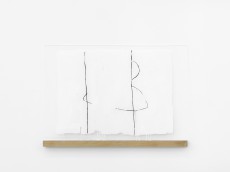
Drawing paper (Wood and Person)
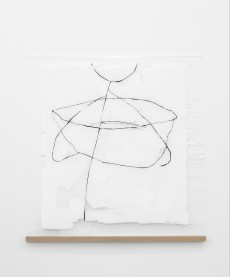
Drawing paper (Big dish, Person)

Drawing paper (Book)

Drawing paper (Rock or Hole, two People)
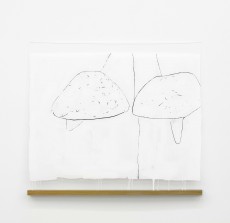
Drawing paper (One has two Stones)

Drawing paper (Stick and Person _Right)
Drawing paper (Stick and Person_left)

Drawing paper (Sea and Moon)

Drawing paper (Bowl)
(above all) photo: YAMAMOTO Tadasu
この現実のむこうに―Here and Beyond
10月28日(土)-12月10日(日)10:00-18:00 会期中無休/無料
本山ゆかり
MOTOYAMA Yukari

撮影:山本糾
描くべき線にむかう
伊藤聡子
これまで絵を描くという行為自体に集中できたためしが無かったのだという本山は(*1)、絵画的な文脈や個人的な思い入れを遮断して、「よい線を描く」という行為のみに向き合う。絵画に含まれるモチーフ、構図、線の描き方などの多くの要素を分解してそれらへの向き合い方を一つずつ見直し、必要だと思うものだけを残す方法で制作された作品が、本展でも発表している「画用紙シリーズ」だ。並べられた絵をよく見ると、表面はアクリル板に遮ぎられて絵の具の物質感を直接つかむことができず、それが板の裏から描かれていることに気づかされる。絵の具の重なりによって時間や感情を物語ることができるであろうマチエールは、ここでは絵を裏返すことで均一化され、線を見ることだけに集中させようとする。一見のびやかで、時にユーモラスに見える線。本山の絵画において、その表面で目にすることのできる線と面が現れる過程から説明したい。
本山の絵に描かれている図像では、それが何であるかを認識するために必要となる線がぎりぎりまで絞られる。何かを説明することになる情報は入っていない。人や、お皿だろうかという推測を残してタイトルを見ると、描かれた図像そのものの単語のみが示されており、確かにそう見える線の存在に改めて目を向けさせる。その線はデジタル上で行われたドローイングをもとにして描かれる。個人的な感情や物語性のあるものは避けて選択された日常の情景、静物や風景は、素早く何枚も繰り返し描かれ、データとして保存されていく。デジタル上では線の重なりやマチエールといった物質的な痕跡が残らないため、ただ線による図のみを判断することになる。そこではさらに時間をかけて線、面、構図の良さが精査され、いくつかの図像へ絞られていく。作品として提示されるのはアクリル板に絵の具を用いて描かれた絵であり、最初に行われるこれらのドローイングは、下絵でも習作でもなく、作品を描くときに見るための「モチーフ」となる。線を簡単に消したり戻したりすることは、描くという行為から一度離れ、モチーフという一般的に絵画を描くときに用いられる静物などの題材を準備するための作業のようだ。アクリル板の上でそれを見ながらその通りによい線を描くことのみに集中するためには、この段階で構図や形などの要素をすべて決定しなければならないため、重要な過程となるのだ。
透明な支持体には絵画空間でいう地はなく、絵のタイトルになっている通り、画用紙自体から描かれることになる。もちろん支持体の上に背景となる地を描くことはあるだろうが、タイトルにあえて「画用紙」とつけることで白い面がその紙であることを示し、本来なら支持体にあたる画用紙を絵として描くことで存在を目の前に提示し転換してみせている。地とは言え、そこでは白の絵の具の厚さによってグラデーションが生まれたり、絵の具が垂れて形を生み出したりしており、図像と同じ階層に位置づけることもできる。描かれる画用紙は、その大きさが作家の意思で自由に変化されるし、従来の「絵を描くための紙」が四角であるという規定さえ無くしてしまう。
さらに展示方法では絵を空間として提示するというより、アクリル板そのものを物質としてみせる方法がとられる。いわゆる絵画の様式であるように壁にかけるのではなく、これらの絵の下には台座が作られ、そこに「置かれて」いる。また、角度をつけて立て掛けることで裏側の存在を示し、絵画は裏側と表側のある「物」であることを提示しているようだ。また、アクリル板という工業製品は、近年の生活では身近過ぎるほど常用され、私たちがイメージを求めて凝視しているスマホやパソコンといった、マチエールを失ったモニター画面を思い出させる。それを扱うことは、デジタルネイティブの作家が生きる時代においてごく自然なことであり、裏から描くことで一つの要素を無くすという本山の手法にも、この透明な板を使うことが必然であったといえるのだろう。そこからなお、透明な板を通して見る線と白の背景に現れる絵の具の垂れや動き、重なりによるグラデーションは、観る者の目をとらえ、画面から浮かび上がってくる。
絵を、線をよく描くために自分にとってそれが何かを探り、獲得するために描く要素を減らしていったその手法は、観る者にも絵の既成概念を問い直すこととなる。作品の根本を支えているのは西洋から輸入されてきたともいえる美術のシステムでしかないのか、ということに虚しさを感じる(*2)という本山ではあるが、ひとつの見方としては、この手法はまた、過去の美術のシステムを壊していく側面を持つ現代美術の上で成り立つことができるともいえるのだろう。
とはいえ、本山はそういったこれまでの絵画の概念を覆す、問い直してみせることを目的とするのではないと思われる。ものごとが溢れ、ただ無防備に過ぎ去っていってしまいそうな潮流の中で危機感を持ち、自分が描くべきものが何なのか、絵画という媒体に真摯に向き合う。のびやかな線の一本一本と形の裏に、絵を描くことの意志を感じることができるのではないだろうか。ドローイングから作品として描かれるまでのシステム化された過程に、再びものを作る、描く人の手を浮かび上がらせるのだろう。そして作家は、一本の線を引くことから絵を描く楽しみを確かめ、また観る者にもその楽しさを思い出させたり思考を与えたりすることができる。
______________________________
*1 高田マル ほか『絵画検討会2016 記録と考察、はじめの発言』、アートダイバー、2016年、p.128。
*2 滞在制作中の聞き取りでの発言(2017年9月22日)。
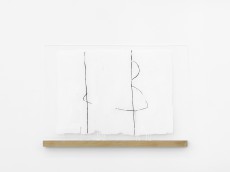
《画用紙(木と人)》

《画用紙(大きな皿、人)》

《画用紙(本)》

《画用紙(岩か穴、二人)》

《画用紙(二つの石を持つ人)》
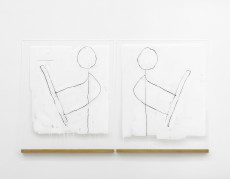
《画用紙(棒と人_右)》
《画用紙(棒と人_左)》
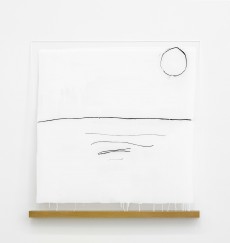
《画用紙(海と月)》

《画用紙(たらい)》
(以上全て)撮影:山本糾
